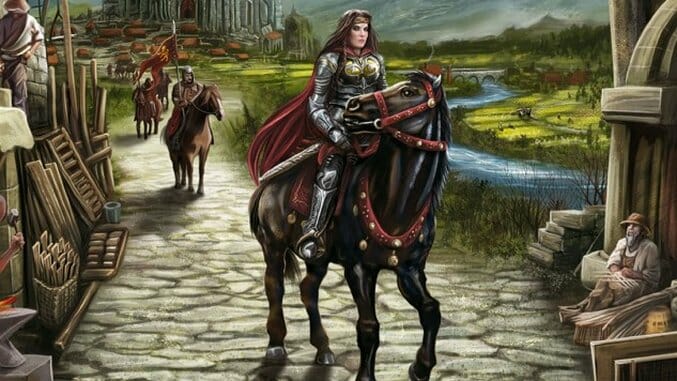
Game designer Marc André created the runaway hit game Splendor, which has since become one of the more successful games to cross over into the mainstream and has spawned a gorgeous app created by Days of Wonder. André’s second game, Barony, hasn’t quite captured the same following, but is another great example of his design style: a game with a short rulebook and quick setup that plays out in under an hour but takes advantage of scarcity to force a lot of tough decisions on players.
Barony is a boardgame with an actual board—how novel!—although it changes each time, as players build it by choosing tiles, each with three hexes on it, and placing them at random to lay out a board with nine tiles per player. Each player then starts the game by placing three of his/her cities on the board, each with one knight on it, a decision that gains no immediate reward but determines almost everything the player can do afterwards. Players then compete to place and move knights around the board, building villages, strongholds and more cities, gaining resources that allow the players to move up the points board. To win, a player must upgrade two villages to cities, and complete four swaps of resource tiles for a gain in title (think baron to marquis, marquis to earl, earl to viscount, viscount to duke), all of which adds up to 80 points, which triggers the end of the game.
The hexes on the board represent five terrain types, each with specific characteristics. Lakes are completely impassable to players, but are beneficial for setting up a line of defense. The other four terrain types are available for construction of villages or strongholds, with each yielding a resource tile of a different value: building on a farm hex is worth five points, on a plains hex is worth four, on a forest is worth three, and on a mountain hex is worth two. Once a player has amassed 15 points in resource tiles, s/he can trade them in to move up one nobility title on the points board, but if you don’t have exactly 15 points you don’t get change back.
Forest hexes can take a village or stronghold, but can’t take a city (which is an upgrade from a village). Mountain hexes can only hold one knight at a time, while the other three land hex types can hold two knights, even of opposing colors. And cities can’t go on adjacent spaces, so a well-placed city blocks your opponent from coming too close with his own; since an opposing knight can’t enter a space with your city or stronghold on it, this also becomes an important part of building your defense.
Defense ends up critical in Barony because there aren’t really quite enough points to go around, unless players build on every hex space and never attack each other… which is a pipe-dream, since eventually one player will realize he can’t win without attacking. Two knights can take out an opposing village if the village doesn’t have another knight on the space; the attacker then gets to steal one resource token from the village’s (former) owner. Because the farm and plains hexes run out quickly, players near the end are left trying to build on all the mountain hexes at two points a pop, or the potentially quicker gain of knocking out someone else’s village for a bigger return and the chance to set an opposing player back.
You do have some methods of defense at your disposal. An opposing player can’t enter a hex with your city or stronghold on it, or a mountain hex with your knight on it, or a hex that has your village and your knight on it. If you set yourself up well enough early on, you can block off your villages from a late-game attack—or invite an opponent to launch an early offensive to stop you from doing this. The game reminds me just a little bit of chess: You’re making moves very early to try to set up a favorable endgame. Chess is substantially more complex, of course, but Barony combines that long-term thinking with the tension you get from a game where there just isn’t enough stuff to go around.
The game’s rules run just three pages, with lots of pictures, and are easy for a child as young as eight to understand; the only difficulty is remembering all of the things you aren’t allowed to do, like putting a city on a forest hex even though a village can go there. With two players, a game can run under a half an hour, with an hour or so typical for four players. With two players, the collisions on the board tend to come a lot later, so it doesn’t quite have the same tension as it does when the third player enters. It’s a solid game for two, and an excellent one for three or four, with high replay value because the board always changes and because one small move early in the game can change the way the endgame plays out.
Keith Law is a senior baseball writer for ESPN.com and an analyst on ESPN’s Baseball Tonight. You can read his baseball content at search.espn.go.com/keith-law and his personal blog the dish, covering games, literature, and more, at meadowparty.com/blog.
